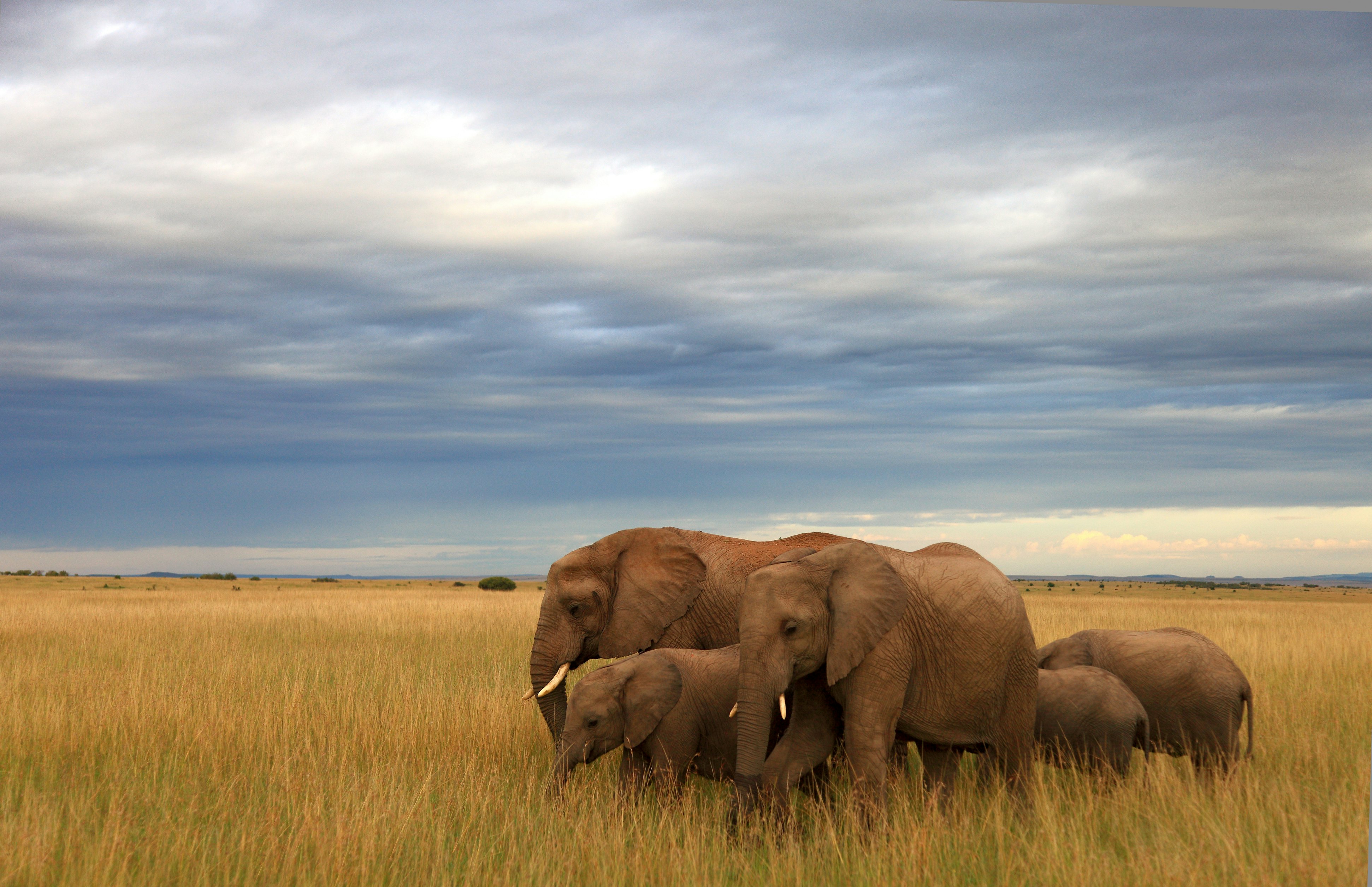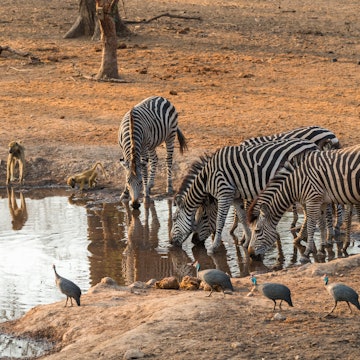
All you need to know about African elephants – and where to spot them in the wild
Apr 25, 2024 • 6 min read

Spotting majestic African elephants in the wild is something you’ll never forget © David Fettes / Getty Images
The African elephant is perhaps the most enduring symbol of nature’s grace and fragility.
These gentle giants are Earth’s largest land mammal and a common sight for those on safari in Africa. Nonetheless, these magnificent beasts are facing unprecedented threats to their existence, making both the imperative to understand more about them and the chance to encounter them in the wild more important than ever.
Let us help you do both.

African elephants 101
An adult African elephant is large. Seriously large: a fully grown male can weigh in at 13,334lb (6048kg), and even the smallest adult male rarely dips below 8820lb (4000kg) – which is two-and-a-half times heavier than your average family car. Females are typically just over half the weight of the male. The size difference narrows when it comes to height: the tallest males are 13ft (4m), with the tallest female rising to 11ft (3.4m). Apart from overall size (and unless the male is, um, aroused), the most obvious difference between males and females is that cows have angular foreheads, with bulls’ foreheads being more rounded.
Apart from humankind, elephants have few natural enemies. In some areas, such as Hwange National Park in Zimbabwe or in the Savuti region of northern Botswana, certain lion prides have learned to hunt infant and adolescent elephants. Thankfully, this isn’t the norm.
Safari animals: the story of lions (and the best places to see them)

The elephant sisterhood
Elephants live in close, cross-generational groups of females. An elephant mother has one of the longest pregnancy periods – some 650 days – in the natural world. Most often, the mother gives birth to a single calf, and that calf will be able to walk (albeit unsteadily) within hours of being born. Baby elephants continue to breastfeed throughout the first two years of their lives, and many will not be truly independent until the age of 10.
If the young elephant is a male, he will leave the herd of its birth somewhere between 10 and 14 years of age. Sometimes this dispersing male will remain alone or attach itself to an experienced larger bull elephant. Young female elephants remain with their natal herd, which may consist of their mother, grandmother, aunts, female cousins and other related females. (What’s not to love?)
This bond with fellow females will endure will last throughout her lifetime. The herd is usually led by an older matriarch, an experienced female that takes the herd to water in times of drought and is the first to stand in defense of the herd’s members.

The most voracious vegetarians
Strict vegetarians, elephants eat grass, leaves, fruits and even branches or twigs. In any 24-hour period, elephants will spend up to 19 hours eating and can eat up to 750lb (340kg) – or around 5% of their not-inconsiderable body weight. If you extrapolate those figures further, elephants consume around 50 tons of food every year. At the other end, elephants defecate up to 30 times a day, depositing as much as 330lb (150kg) of dung in the process. This waste serves a critical ecological purpose, spreading undigested seeds (a food source for insects, baboons and birds), in turn enabling trees to spread their progeny. One study found that a single piece of elephant dung contained nearly 5700 acacia seeds.
Elephants drink between 26 to 52 gallons of water per day. And for good reason: an elephant loses as much as a gallon of moisture every hour through the process of transepidermal (through the skin) water loss, and urinates up to 13 gallons each day.

A country-by-country guide to seeing elephants on safari
Of the two species of African elephant, the much larger bush elephant is most commonly found in the savanna and light woodlands of East Africa and Southern Africa, with smaller populations in West Africa. The forest elephant, meanwhile, is predominantly found in the forests of Central Africa, although they can range into East and West Africa, too.
The 2016 Great Elephant Census – the most comprehensive survey of elephants ever undertaken – counted 352,271 African bush (or savanna) elephants spread across 18 countries.
Elephants in Botswana
Botswana counts more elephants than any other country: over 130,000 as of 2016. Anywhere in the Okavango Delta can be outstanding for elephant lovers, but Chobe National Park truly stands out, with its populations of elephants in big herds.
Elephants in Kenya
Kenya has some of the best elephant watching on the continent. We recommend the spotting at Amboseli National Park; the Masai Mara, Tsavo East and Tsavo West national parks, as well as the Samburu National Reserve, are excellent as well.

Elephants in South Africa
A justly popular destination for visitors, Kruger National Park is prime elephant-watching choice. Addo Elephant National Park is South Africa’s third-largest national park and offers some of the world’s best elephant viewing.
The 15 best things to do in South Africa
Elephants in Namibia
Etosha National Park is your best bet. Seeing the desert-adapted elephants of Damaraland, also in the country’s north, is another highlight.
Elephants in Tanzania
While Tanzania’s elephant population is declining, sightings remain generally excellent in the Serengeti, Lake Manyara, Tarangire and Ruaha national parks.

Elephants in Zambia
South Luangwa National Park offer the best elephant spotting in Zambia.
Elephants in Zimbabwe
As of 2016, Zimbabwe had more than 80,000 elephants, second only to Botswana. Try Hwange and Mana Pools national parks: the former is home to half of Zimbabwe’s elephants.
Elephants in Malawi
Malawi’s Nkhotakota Wildlife Reserve is a lovely park, especially since the recent and historic translocation of 500 elephants to its borders.
The best times to visit Malawi
Elephants in Mozambique
In Mozambique, Gorongosa National Park is brilliant for elephants.

Elephants in peril
Thanks to the ivory in their tusks and the material’s enduring popularity (particularly in Asia), elephants have been poached in unsustainable numbers since the 1970s – and their numbers have fallen dramatically as a result. The African elephant is listed as vulnerable by the International Union for the Conservation of Nature (IUCN).
In the 1970s and ’80s, poaching caused the numbers of African elephants to crash from around 1.3 million to 500,000. The slaughter ended only in 1989, when the trade in ivory was banned under the Convention for International Trade in Endangered Species (CITES). After the ban, world raw ivory prices plummeted by 90%, and the market for poaching and smuggling was radically reduced. The same year, Kenyan President Daniel arap Moi dramatically burned 12 tons of ivory in Nairobi National Park as a symbol of Kenya’s resolve in the battle against poachers.
But poaching is again on the rise. Africa has lost more than 30,000 elephants a year since 2010. That’s around 7% of Africa’s elephant population every year. Or 673 elephants being killed a week. Or 96 a day. Ot four elephants being killed for their tusks every hour.
In 2014, for the first time in decades, a critical threshold was crossed when more elephants were being killed on the continent than were being born.

The 2016 Great Elephant Census recorded a 30% decrease in Africa’s elephant populations in just seven years – although there was good news alongside the bad. Kenya’s elephant population, for example, was considered to be “relatively stable,” at 25,959; Uganda’s 4864 elephants, meanwhile, provided cause for optimism after the country’s elephant population had fallen to just 800 during the 1980s. Tanzania, on the other hand, saw a catastrophic 60% decline in elephant numbers in the five years to 2016, with just 42,871 elephants – and 2.6 carcasses spotted for every live counterpart.
In 2023, an aerial survey of the Kavango Zambezi Transfrontier Conservation Area, which covers 40,000 miles across five Southern African countries, happily reported that the region’s elephant population – the continent’s largest – was stable. The conservation community awaits more data to show whether or not their efforts to save the elephant have stemmed the tide of killings.
Safari animals: the story of rhinos (and the best places to see them)













